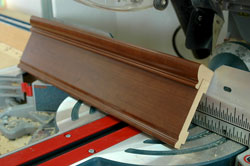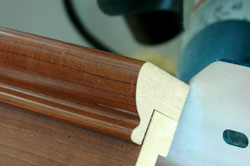 Real wood is a great thing, but high-quality substitutes are becoming so convincing that they’ve got to make you think. They certainly have that effect on me. Something called wrapped profiles are a particularly impressive case in point. They’re high-quality photographic reproductions of wood grain applied to trim, moulding and bevel-edged paneling and I’ve got to sheepishly admit that I like them. I’m a cabinetmaker by trade, I’m not supposed to like fake wood, and even though I know cherry, oak, walnut and other species intimately from years of working with them, I can’t detect the impostors from the real thing without getting closer than a foot away. What’s most striking to me in all this is that the wood-look layer can be applied to non-flat surfaces like window and door trim, wainscoting panels, crown moulding and anything that’s traditionally milled from solid wood. This is where the term wrapped profiles comes from.
Real wood is a great thing, but high-quality substitutes are becoming so convincing that they’ve got to make you think. They certainly have that effect on me. Something called wrapped profiles are a particularly impressive case in point. They’re high-quality photographic reproductions of wood grain applied to trim, moulding and bevel-edged paneling and I’ve got to sheepishly admit that I like them. I’m a cabinetmaker by trade, I’m not supposed to like fake wood, and even though I know cherry, oak, walnut and other species intimately from years of working with them, I can’t detect the impostors from the real thing without getting closer than a foot away. What’s most striking to me in all this is that the wood-look layer can be applied to non-flat surfaces like window and door trim, wainscoting panels, crown moulding and anything that’s traditionally milled from solid wood. This is where the term wrapped profiles comes from.
The first thing you should know is that wrapped profile products are much tougher than even the hardest hardwoods and finishes. Based on the same materials used to create laminate flooring, it’s virtually impossible to scratch profile-wrapped surfaces. You can even go at them vigorously and intentionally with a car key and nothing nasty happens.
Price is another huge advantage. Wrapped profiles cost less than 50% of nearly-identical hardwoods and they’re also environmentally preferable. Since the visible layer is applied to composite engineered wood products like plywood and high density fiberboard, they take considerable pressure off over-harvested forests. My favourite domestic hardwood is cherry, but I’ve got to admit that a standing cherry forest is at least as nice looking as a well finished cherry-wood surface. Wrapping technologies certainly won’t eliminate real wood from the market, but they do help more people enjoy the look of authentic wood than international forests can support sustainably.
 So how does all this translate into trim choices for your home? Several ways, and wainscoting is one of them. While traditional, solid hardwood wainscoting is expensive to buy and requires finishing on site, wainscoting made with wrapped profiles goes up quickly and with much less skill. It also requires no finishing. You can even specify that wrapping materials include anti-microbial treatments, making disease transmission less of an issue, especially in institutional settings.
So how does all this translate into trim choices for your home? Several ways, and wainscoting is one of them. While traditional, solid hardwood wainscoting is expensive to buy and requires finishing on site, wainscoting made with wrapped profiles goes up quickly and with much less skill. It also requires no finishing. You can even specify that wrapping materials include anti-microbial treatments, making disease transmission less of an issue, especially in institutional settings.
Since the wood-look skin used for wrapping is impervious to the transmission of gases, completely wrapped items like kitchen cabinet doors also eliminate any chance of formaldehyde gas emissions to the surrounding air. Surfaces also never get marked or greasy the way wood kitchen cabinet doors do after years of service. Elite Trimworks (www.elitetrimworks.com; 888.898.1665) is the first Canadian supplier of wrapped architectural products that I know of. They’ve pioneered the option of offering wrapped profile products at the retail level, but something has yet to happen in mainstream retailer outlets.
I’ve worked with wrapped trim, moulding and wainscoting in my own shop and building projects, and it saws and nails just like real wood. Industry players have also worked hard to match the colour and grain pattern of wrapped products with melamine building materials. This means that over 600 different colours and patterns of sheet goods and other low-density laminate flat panels of the sort used to build cabinets match perfectly with wrapped trim of all kinds.
I’ll probably never feel completely at ease with the increasing levels of realistic fake wood products in the world, but that doesn’t mean I don’t think they’re a good idea. They’re strikingly beautiful, surprisingly durable, reasonably priced and environmentally sound. How can I argue with practical virtues like these?


